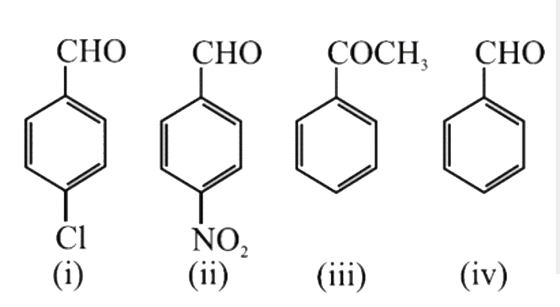Arrange the following compounds in increasing order of their reactivity in nucleophilic addition reactions.
(i) Ethanal, Propanal, Propanone, Butanone.
(ii) Benzaldehyde, p-Tolualdehyde, p-Nitrobenzaldehyde, Acetophenone.
Hint: Consider steric effect and electronic effect.
To arrange the given compounds in increasing order of their reactivity in nucleophilic addition reactions, we need to consider both steric effects and electronic effects. Let's analyze each set of compounds step by step.
(i) Ethanal, Propanal, Propanone, Butanone
1. Identify the structures:
- Ethanal (CH3CHO)
- Propanal (CH3CH2CHO)
- Propanone (CH3COCH3)
- Butanone (CH3C(O)CH2CH3)
2. Evaluate steric hindrance:
- Ethanal has no bulky groups, making it the least hindered.
- Propanal has one more carbon chain than ethanal, leading to slightly more steric hindrance.
- Propanone has two methyl groups attached to the carbonyl carbon, which creates more steric hindrance than ethanal and propanal.
- Butanone has an additional carbon chain, resulting in the most steric hindrance.
3. Order based on steric hindrance:
- Least steric hindrance: Ethanal < Propanal < Propanone < Butanone
- Therefore, the order of reactivity in nucleophilic addition is:
- Increasing order of reactivity: Butanone < Propanone < Propanal < Ethanal
(ii) Benzaldehyde, p-Tolualdehyde, p-Nitrobenzaldehyde, Acetophenone
1. Identify the structures:
- Benzaldehyde (C6H5CHO)
- p-Tolualdehyde (C6H4(CH3)CHO)
- p-Nitrobenzaldehyde (C6H4(NO2)CHO)
- Acetophenone (C6H5C(O)CH3)
2. Evaluate electronic effects:
- p-Nitrobenzaldehyde has a strong electron-withdrawing nitro group, making the carbonyl carbon more electrophilic and thus more reactive.
- Benzaldehyde has no substituents that significantly affect reactivity.
- p-Tolualdehyde has a methyl group, which is an electron-donating group, making it less reactive than benzaldehyde.
- Acetophenone has a methyl group attached to the carbonyl carbon, which also decreases reactivity compared to p-nitrobenzaldehyde.
3. Order based on electronic effects:
- Most reactive: p-Nitrobenzaldehyde > Benzaldehyde > p-Tolualdehyde > Acetophenone
- Therefore, the order of reactivity in nucleophilic addition is:
- Increasing order of reactivity: Acetophenone < p-Tolualdehyde < Benzaldehyde < p-Nitrobenzaldehyde
Final Answers:
1. Increasing order of reactivity for (i): Butanone < Propanone < Propanal < Ethanal
2. Increasing order of reactivity for (ii): Acetophenone < p-Tolualdehyde < Benzaldehyde < p-Nitrobenzaldehyde
- Ethanal (CH3CHO)
- Propanal (CH3CH2CHO)
- Propanone (CH3COCH3)
- Butanone (CH3C(O)CH2CH3)
- Ethanal has no bulky groups, making it the least hindered.
- Propanal has one more carbon chain than ethanal, leading to slightly more steric hindrance.
- Propanone has two methyl groups attached to the carbonyl carbon, which creates more steric hindrance than ethanal and propanal.
- Butanone has an additional carbon chain, resulting in the most steric hindrance.
- Least steric hindrance: Ethanal < Propanal < Propanone < Butanone
- Therefore, the order of reactivity in nucleophilic addition is:
- Increasing order of reactivity: Butanone < Propanone < Propanal < Ethanal
- Benzaldehyde (C6H5CHO)
- p-Tolualdehyde (C6H4(CH3)CHO)
- p-Nitrobenzaldehyde (C6H4(NO2)CHO)
- Acetophenone (C6H5C(O)CH3)
- p-Nitrobenzaldehyde has a strong electron-withdrawing nitro group, making the carbonyl carbon more electrophilic and thus more reactive.
- Benzaldehyde has no substituents that significantly affect reactivity.
- p-Tolualdehyde has a methyl group, which is an electron-donating group, making it less reactive than benzaldehyde.
- Acetophenone has a methyl group attached to the carbonyl carbon, which also decreases reactivity compared to p-nitrobenzaldehyde.
- Most reactive: p-Nitrobenzaldehyde > Benzaldehyde > p-Tolualdehyde > Acetophenone
- Therefore, the order of reactivity in nucleophilic addition is:
- Increasing order of reactivity: Acetophenone < p-Tolualdehyde < Benzaldehyde < p-Nitrobenzaldehyde
1. Increasing order of reactivity for (i): Butanone < Propanone < Propanal < Ethanal
2. Increasing order of reactivity for (ii): Acetophenone < p-Tolualdehyde < Benzaldehyde < p-Nitrobenzaldehyde
Topper's Solved these Questions
- ALDEHYDES, KETONES AND CARBOXYLIC ACIDSBook:NCERTChapter:ALDEHYDES, KETONES AND CARBOXYLIC ACIDSExercise:Exercise
Explore 28 Videos
- ALCOHOLS, PHENOLS AND ETHERSBook:NCERTChapter:ALCOHOLS, PHENOLS AND ETHERSExercise:EXERCISE
Explore 45 Videos
- AMINESBook:NCERTChapter:AMINESExercise:Exercise
Explore 23 Videos
Similar Questions
Arrange the following carbonyl compounds in the increasing order of their reactivity in nucleophilic addition reactions :
(i) Ethanal, propanal, propanone, butane
(ii ) Benzaldehyde, p-tolualdehyde, p-nitrobenzaldehyde , acetophenone
View SolutionArrange the following in increasing order of their reactivitty in nucleophilic addition reactions :
(i) Ethananl, Propanal, Propanone, Butanone.
(ii) Benzaldehyde, p - Tolualdehyde, p - Nitrobenzaldehyde, Acetophenone.
[Hint : Consider steric effect and electronic effect.]
View Solution
Knowledge Check
Arrange the following compounds in increasing order of their reactivity in nucleophilic addition reactions.
Ethanal, Propanal, Propanone, ButanoneAButanone lt Propanone lt Propanal lt EthanalBPropanone lt Butanone lt Ethanal gt PropanalCPropanal lt Ethanal lt Propanone lt ButanoneDEthanal lt Propanal lt Propanone lt ButanoneArrange the following carbonyl compounds in increasing order of their reactivity in nucleophilic addition reaction.
AButanone < propanane < propanal < ethanalBButanone < propanal < propanone < ethanalCButanone < ethanal < propanone < propanalDButanone < ethanal < propanal < propanoneArrange the following compound in an increasing order of their reactivity in nucleophilic addition reactions : ethanal propanal, butanone, propanone.
AIII lt II lt I lt IVBII lt I ltIII lt IVCIV lt III lt II lt IDI lt II lt III lt IV
Arrange the following compounds in an increasing order of their reactivity in nucleophilic addition reaction : ethanal, propanal, propanone, butanone.
View SolutionArrange the following carbonyl compounds in the increasing order of their reactivity in nucleophilic addition reactions :
(i) Ethanal, propanal, propanone, butane
(ii ) Benzaldehyde, p-tolualdehyde, p-nitrobenzaldehyde , acetophenone
View SolutionArrange the following carbonyl compounds in decreasing order of their reactivity in nucleophilic addition reaction :

View SolutionArrange the following compound in an increasing order of their reactivity in nucleophilic addition reactions : ethanal propanal, butanone, propanone.
View SolutionArrange the following compound in an increasing order of their reactivity in nucleophilic addition reactions : ethanal propanal, butanone, propanone.
View Solution

